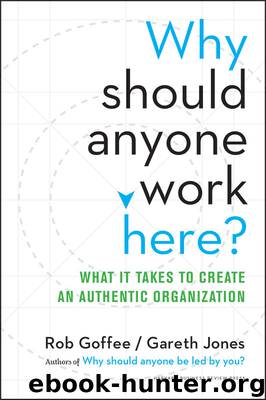Why Should Anyone Work Here?: What It Takes to Create an Authentic Organization by Rob Goffee & Gareth Jones

Author:Rob Goffee & Gareth Jones [Goffee, Rob]
Language: eng
Format: epub, mobi
ISBN: 9781625275103
Publisher: Harvard Business Review Press
Published: 2015-10-12T22:00:00+00:00
Model Leaders
A final characteristic of authentic organizations is that they have authentic leaders. This may sound like a circular statement of the obvious, and it’s true that it can often be difficult to determine which comes first. Let’s return to the soccer club example to illustrate this point.
Much of Manchester United’s recent success is attributed to the leadership of Sir Alex Ferguson. During his twenty-six years in charge, he became perhaps the most successful coach in all sports. The team won thirteen English League titles and twenty-five other domestic and international trophies. Right from the start, Ferguson saw himself as building a club rather than a particular team. In his words, this involved building from the bottom up. Establishing a strong youth structure was critical for this objective. This meant holding on to a long-term perspective in a notoriously results-driven industry. But Ferguson was prepared to forgo short-term success for long-term achievement. This approach played into something that Ferguson felt fitted the club’s early history and culture, which always had been characterized by the development of young players. In the 1950s, that culture was immortalized in the achievements of the legendary “Busby Babes” (as the Manchester United was nicknamed at the time)—a team of outstanding young players, many of whom were tragically killed in what’s been called “the Munich air disaster” (a British European Airways crash in February 1958). With his focus on young players, then, Ferguson evoked the past while he worked to build for the future. Not unlike the training centers at Unilever and elsewhere mentioned earlier, Ferguson combined tradition with modernity.
Another example comes from Belmiro de Azevedo, probably Portugal’s most famous businessman. We have known Belmiro for many years. He is a formidable personality with a wonderful track record as an entrepreneur, executive, and leader. As we completed this book Belmiro was completing fifty years with Sonae—a highly successful business with interests in retailing, media, information systems, and telecommunications. Belmiro personally embodies many of Sonae’s key features: resilient, hardworking, determined, competitive, and focused on performance. We celebrated this winning culture in our earlier book, The Character of a Corporation.
Sonae has its origins in wood laminates—a business represented now by Sonae Industria. So where was the commemorative celebration held? In a huge Sonae Industria warehouse especially converted for the occasion. Wooden pallets were the materials for exhibits recording Belmiro’s life and achievements. Behind the orchestra on stage, shipping containers were artfully arranged and lit. The several hundred guests included many VIPs—but at Belmiro’s table sat only his grandchildren and his wife. The event was a marvelous ritual celebration of authenticity as reflected in exemplary leadership, historic roots, and strong values.
You don’t need to be at the top of hierarchies, however, to be a leader who models the kinds of values that underpin authentic organizations. While researching this book, we met a young African American catering manager in a US business school who had been given the daunting task of building a catering outlet, from scratch, that would attract students to work, play, and learn together.
Download
Why Should Anyone Work Here?: What It Takes to Create an Authentic Organization by Rob Goffee & Gareth Jones.mobi
This site does not store any files on its server. We only index and link to content provided by other sites. Please contact the content providers to delete copyright contents if any and email us, we'll remove relevant links or contents immediately.
| Ethics | Etiquette |
| Fashion & Image | Health & Stress |
| Motivation & Self-Improvement | Work Life Balance |
| Workplace Culture |
Tools of Titans by Timothy Ferriss(8225)
Change Your Questions, Change Your Life by Marilee Adams(7638)
Deep Work by Cal Newport(6887)
Playing to Win_ How Strategy Really Works by A.G. Lafley & Roger L. Martin(5936)
Man-made Catastrophes and Risk Information Concealment by Dmitry Chernov & Didier Sornette(5926)
Digital Minimalism by Cal Newport;(5667)
Big Magic: Creative Living Beyond Fear by Elizabeth Gilbert(5616)
The Slight Edge by Jeff Olson(5353)
Ego Is the Enemy by Ryan Holiday(5297)
The Motivation Myth by Jeff Haden(5158)
Stone's Rules by Roger Stone(5027)
The Laws of Human Nature by Robert Greene(5003)
Tuesdays with Morrie by Mitch Albom(4696)
Eat That Frog! by Brian Tracy(4438)
Rising Strong by Brene Brown(4380)
Skin in the Game by Nassim Nicholas Taleb(4165)
Bullshit Jobs by David Graeber(4101)
The Money Culture by Michael Lewis(4083)
Skin in the Game: Hidden Asymmetries in Daily Life by Nassim Nicholas Taleb(3935)
